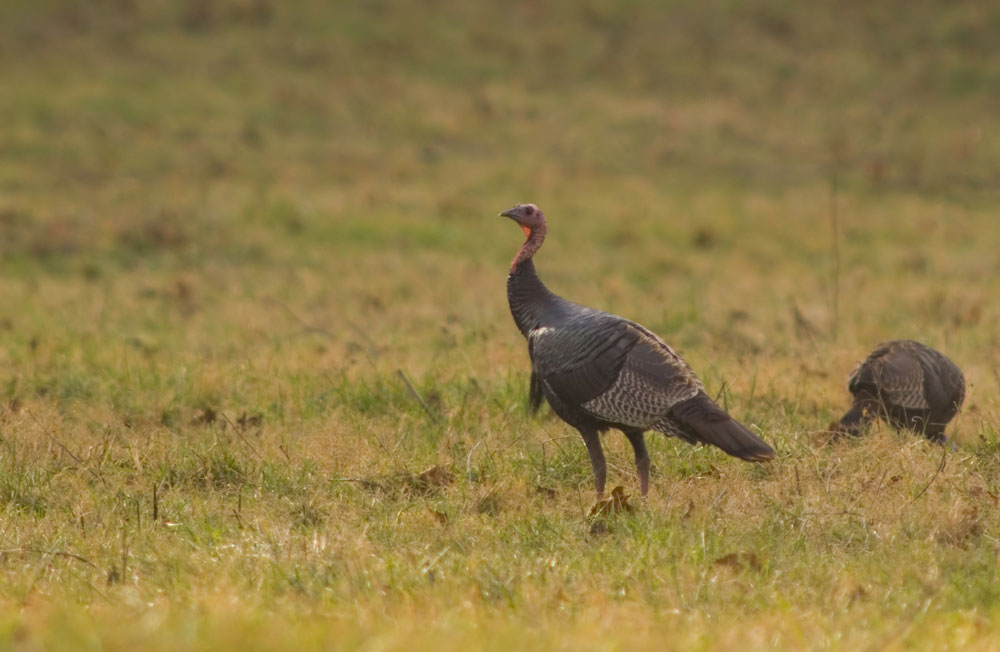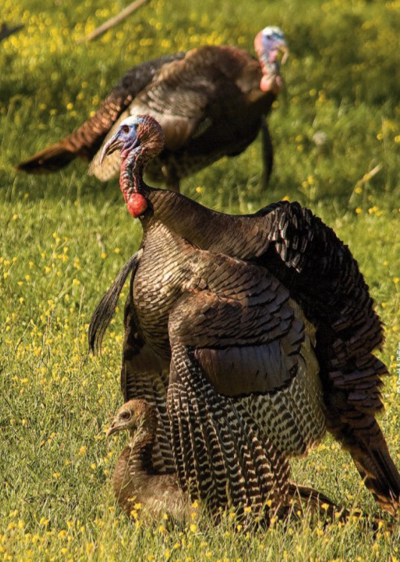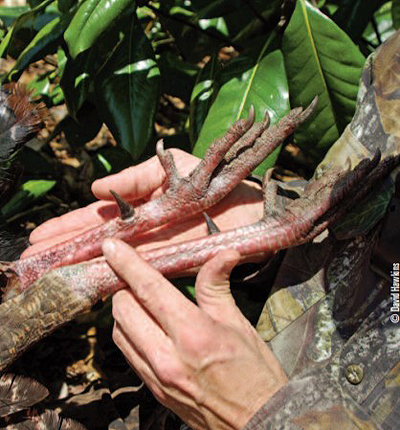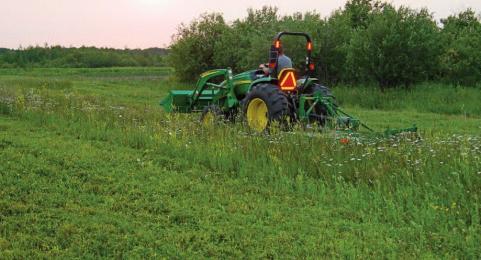David Hawkins | Originally published in GameKeepers: Farming for Wildlife Magazine. To subscribe, click here.

The Eastern wild turkey spends the greater part of its life searching for food. Being an opportunistic forager, the turkey has been compared to the goat of the mammalian world. According to a study in Texas, which is home to three subspecies, the annual diet of a wild turkey is made up of 36% grasses, 29% insects, 19% mast and 16% forbs. The big birds have also been known to consume worms, snails, salamanders, lizards, small snakes, spiders and ticks.
This information might cause a land manager to pause and ask what needs to be done to provide food these birds – can’t turkeys get enough from forests and fields as they exist now? If turkeys are found there now, they must be getting just what they need. Yes, possibly, but as forests and fields evolve there is a host of practices that will allow a gamekeeper to enhance their property, creating prime turkey habitat.
Researchers at Mississippi State University have written that turkeys require a variety of habitat types, including forests, open lands and old fields. In a pamphlet titled Forest Management for Wild Turkeys, Dr. Bronson Strickland writes that adequate forestland is critical to maintaining viable populations of wild turkeys, particularly when forest management provides a mix of different forest types, ages and openings that can provide various food sources, brood rearing habitat, edges for nesting, and room for courtship. Turkeys do well in forested landscapes with 15-65 % openings, whether in fields, cropland, pastures, or early successional stages of forestland.

Turkey habitat is fluid. In forest land for instance, prescribed burning is highly recommended as a way to create feeding sites. Hens like to nest in pine stands, including mature stands and young plots (2-4 years old), but don’t care for stands less than 2 years or older than 4 years. Once a stand has been thinned, at around 15 to 20 years old, they will return to the pines to nest and brood. A good game manager will work their forest on a rotational basis to obtain optimum results. In every case, plantings, burnings, clipping and thinning are needed to maintain the perfect balance.
“Overall, you can maintain the vegetative conditions necessary for nesting by late-winter burning at intervals of 3 years. You can also mow or bush-hog, but you should not burn, mow or bush-hog during the spring to early summer nesting season (March to July),” Dr. Strickland said. “Thinning and burning pine plantations improve brood habitat conditions. Patchy burns, with burned areas next to unburned areas, provide the best habitat.”
It goes without saying that improving turkey bugging habitat begins with improved insect habitat. All those spring and summer plantings done for deer or upland game will foster good insect habitat. Of these, the best may be clover which can withstand browsing and maintain a root system that will spur regeneration. Of course, corn crops planted with forage soybeans or iron clay peas will provide an excellent bugging site through the fall frost.
Millet, sorghum, and other grain crops offer turkeys a mixed bag of insects and seed, but taller crops will actually impede turkeys because the crops rise above their eye level, allowing predators a better ambush opportunity. For this reason, strip planting is an excellent idea. Recommendations are for 20-foot wide strips of alternating crops. On the same token, pastures and hay producing land is ideal bugging habitat. What hunter hasn’t been frustrated by a strutting gobbler with a flock of hens in the middle of a field? He might gobble at your every call but he will not leave the ladies for even your sweetest yelps. What are the hens doing while he struts his stuff – they are stuffing themselves with insects and seeds and such.
Connecting the Dots
Every gamekeeper should have a good quality aerial photograph of their property. These maps are available from a variety of sources such as the Department of Agriculture’s Natural Resource Conservation Service or from online sources such as Google Pro. Label those areas where little or no work is needed. With a color marker, indicate where ATV trails, logging roads and established food plots exist. Make a note of adjoining properties where timber or farming operations might affect turkey movement.
With all these areas identified it is easier to prioritize the methods needed to connect the dots, so to speak, with travel corridors turkeys can use. A simple place to begin is a roosting site. This may be on your property or on a neighbor’s property. New roosting sites cannot be created overnight, but locating existing roosting sites will give the land owner/manager an idea of the direction turkeys may travel once they fly down. If there is an opening near the roost, the birds may simply sail into that opening with little or no wing flapping. If you don’t know if turkeys are roosting on your property, you haven’t spent enough time on your place.
Taking a long look at your property map, determine what impedes flock movement from one food source to another. It could be a dense thicket, or a body of water. Not much can be done about the water, but the thicket is easily addressed. A controlled burn might be a good start as it will remove most of the litter from the vines and small brush.

reasons, one developing bugging habitat. Let’s qualify that
by saying “productive” open areas. Just one of the other
many reasons they need open areas is to attract a mate.
A chemical treatment may be in order if the thicket consists of privet, kudzu, or cogon grass, all invasive species. Arsenal herbicide is considered by many to be the gold standard for controlling the understory of thinned pine plantations, however, a broadcast is not recommended when it comes to turkey habitat management. Spot use of Arsenal allows selective management of invasive species without removing the native soft mast plants such as blackberry and dogwood. A hack and squirt procedure is more time-consuming but better targets undesirables while allowing desirables to flourish.
Let the Sun Shine in
One of the land use issues plaguing land managers in Texas is wall-to-wall reforestation. This is an issue faced by many states in the southeast as well. As pointed out previously, pine plantations have benefit to turkey populations during certain stages of growth, but as the forest grows, it becomes a benefit with diminishing returns as far as wildlife value.
“Land management in East Texas has changed greatly,” said Gary Calkins, District 6 Leader for the Texas Parks and Wildlife Department. “Old fields such as those that existed during the days of sharecropping or small acreage family farms are being replaced by pine plantations with too few openings for turkeys. Much of our turkey habitat is badly in need of thinning and burning.”
District 6 biologists are urging landowners to set aside 7-1/2 percent of their property into openings. In addition, they recommend day-lighting the roads by either not planting or removing three rows of trees along either side. This will allow more wildlife browse as well as improving the roadbed by allowing it to remain drier.
“Consider this,” Calkins said. “In the first couple of years following a planting, turkeys are provided with nesting and feeding opportunities in abundance. Then the pines begin to canopy and will not be open to sunlight until 15-18 years later when thinning will occur as a normal forest management practice. After thinning, and a possible prescribed burn, sunlight will again reach the forest floor and spur the growth of forbs and grasses. Thinning also creates nesting areas. Rotating harvest and planting is critical to maintaining wildlife habitat.”
Once the canopy has been opened, it is time to decide what is necessary to enhance the forage underneath. Typically, timber land is low in fertility and has a low ph factor. Mossy Oak offers a fertilizer with lime just for such conditions. Where no previous fertilizer has been broadcast, apply at a rate of 400 pounds per acre. Using an 8-8-8 formulation (the rest being a fast-acting lime) the added lime will boost the pH of the soil one full point when applied at the recommended rate.
Fire as a Management Tool
“Even after decades of research, there is still much to learn about the wild turkey,” NWTF Biologist Tom Hughes said. “However, one thing we are sure of based on many research projects is the importance of good nesting and brood rearing habitat to wild turkey productivity and population growth. We also know that for many areas, prescribed fire is usually the most effective and cost efficient method of providing this critical early successional habitat.”
Hughes points to several studies done in Louisiana, Georgia and Arkansas that gamekeepers may find helpful. Where burns are very large, say 5,000 acres or more, hens may try to nest in the burned over traditional nesting area, perhaps in small unburned pockets or low places. Predictably nesting success is greatly reduced. Less than 10% success was not uncommon. Where smaller burns were used allowing adjacent nesting areas to remain unburned the nesting rate averaged 40% or greater.
“It is likely that the mosaic pattern of these small-scale fires left numerous high-quality nesting sites, allowing for good nesting success and facilitating re-nesting attempts,” Hughes said. “By rotating the burns on a three-year pattern good, habitat can be maintained for both nesting and bugging.”

bugging habitat. Just below those big, limb-hanging spurs
are a “turkey’s utensils.” Those claws scratch through leaf
litter and forest debris to find beetles, worms, snails,
centipedes and other creepy-crawlers that thrive in the
rotting litter on the forest floor.
Studies also point out turkeys benefit from bugging opportunities and roosting options in mature hardwoods. Where leaves are allowed to cover the ground, a host of little critters come to live. Beetles, worms, snails, centipedes, and salamanders thrive in the rotting litter on the forest floor. In addition, some hard mast in the form of acorns may also allow the birds to gather some late-season protein. Periodic burning can be beneficial in hardwoods as well, by removing unwanted brush and canes.
Predation
As we till, burn, thin and plant, we must be conscious of those factors we have created that will be detrimental to turkeys. Consider for a moment the predators that prey on the turkey in one way or another.
Wild hogs are an invasive species that destroy habitat and compete for food. Maintaining a hog population (not that you want to) means removing 75-percent of the animals annually. Trapping an entire sounder is the most effective means of removing large numbers, but that works only until another breeding pair from across the way ventures over to set up housekeeping at your place.
Perhaps the apex predator for turkeys is the raccoon. These masked marauders have amazing skills to learn and adapt to a variety of surroundings. According to NWTF Biologist Tom Hughes, where pine stands have been thinned and nesting habitat has occurred, raccoons have learned to travel the cleared lanes to seek for nests. They do this by traveling the lanes and trying to smell the nests from downwind. For this reason, land managers need to open a few lanes for bugging and travel, but leave larger blocks for nesting, making it more difficult for the raccoons to hunt.
Skunks, weasels, minks, snakes and crows are also known to raid a turkey nest if they have the opportunity. Hawks and owls are not known to prey on nests, but will kill and eat young poults. Even fire ants are a danger when the chicks are hatching. It seems young birds have a lot going against them.
Turkey habitat management, as it is with all wildlife management, is an ongoing endeavor. Doing right by the species is also doing right by the land. Maintaining the land is a sacred trust. There is a little of Antaeus (a figure in Greek mythology who gained strength by maintaining contact with the earth) in all of us who work the earth. We gain strength and hope from the work we do – knowing it will be another’s someday. But the work we do now will endure long past the time when people no longer visit our graves, or remember our toil. Let alone the earth will heal itself over time if given the chance, until another set of gamekeepers resume the commitment to do the right thing.




























